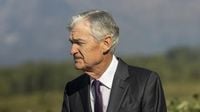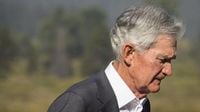Federal Reserve chair Jerome Powell stood at the podium of the Jackson Hole symposium on August 22, 2025, and delivered what many are calling his most consequential—and possibly final—address as head of the U.S. central bank. The annual gathering in Wyoming, nestled amid the Teton mountains, has long been a stage for major policy signals. This year, Powell’s words reverberated far beyond the mountain valley, sending financial markets surging and reigniting a fierce debate about the future of U.S. monetary policy.
Powell’s speech was, by all accounts, a careful balancing act. He acknowledged the economy’s shifting landscape, especially the labor market’s peculiar state. "While the labor market appears to be in balance, it’s a curious kind of balance that results from a marked slowing in both the supply of and demand for workers," Powell said, according to NPR. He described this as an "unusual situation"—one that suggests "downside risks to employment are rising. And if those risks materialize, they can do so quickly, in the form of sharply higher layoffs and rising unemployment."
That warning landed with particular force. Over the past year, the U.S. economy has weathered a series of shocks: persistent inflation, a slowing job market, and the ongoing effects of President Donald Trump’s tariffs. The Fed’s own policymakers are divided on how to respond, and Powell’s speech made clear that the path forward is anything but certain.
Still, Powell opened the door to a possible interest rate cut as soon as the Fed’s mid-September meeting. He stopped short of promising action, emphasizing that any decision "will be based solely on their assessment of the data and its implications for the economic outlook and the balance of risks"—a pointed rejection of President Trump’s repeated calls for lower rates to reduce government borrowing costs, as reported by Axios. "We will never deviate from that approach," Powell insisted, drawing a rare standing ovation from the international audience of economists and central bankers.
Stocks wasted no time reacting. The Dow Jones Industrial Average soared nearly 900 points, or almost 2%, in the first hour after Powell’s remarks, according to NPR. Investors interpreted the speech as a clear signal that the Fed is ready to act if economic data continues to deteriorate. Peter Boockvar, an independent economist, summed up the market mood in a note: "Today’s speech could not be more clear that Powell is ready to cut rates on September 17th and the market is now fully priced for it and for a 2nd one by year end."
But beneath the market’s euphoria lies deep uncertainty. The labor market, as Powell and several other Fed officials noted, is in flux. Demographic changes, such as the retirement of more than 10,000 baby boomers each day, and a sharp decline in immigration—driven in part by Trump’s crackdown—mean the U.S. workforce is growing slowly, if at all. San Francisco Fed President Mary Daly captured the anxiety: "The labor market has softened, and I would see additional slowing as unwelcome. Once the labor market stumbles, it tends to fall quickly and hard," she wrote on LinkedIn, as cited by Bloomberg.
Other Fed policymakers are also voicing concern. In July, Governor Christopher Waller and Vice Chair for Supervision Michelle Bowman dissented from the central bank’s decision to hold rates steady for the fifth consecutive time, instead supporting a quarter-point rate cut due to labor market weakness. Boston Fed President Susan Collins told The Wall Street Journal that a rate cut in September would be appropriate if the labor market weakens more than price pressures increase. Both Collins and Chicago Fed President Austan Goolsbee, who expressed unease over a recent spike in services inflation, have voting rights on rate decisions this year.
Inflation remains a stubborn challenge. Powell acknowledged that the effects of Trump’s tariffs "are now clearly visible" in consumer prices and are expected to "accumulate over coming months, with high uncertainty about timing and amounts." However, he argued that these effects are likely to be "relatively short-lived"—a one-time adjustment rather than an ongoing inflationary process. Still, the latest Producer Price Index showed a 0.9% surge in July, much higher than economists had anticipated, raising fears that inflation could prove more persistent than hoped.
The internal debate within the Fed is as intense as ever. Some members believe that inflation caused by tariffs will fade quickly and that lower rates are needed to counteract a deteriorating job market. Others caution that it’s too soon to tell how long price increases will last and that the labor market, while cooling, does not yet warrant emergency intervention. "Core inflation is still stubborn and the labor market, while showing some signs of cooling, isn’t screaming for emergency intervention," wrote Kevin Ford, strategist at Convera financial group, in a note to clients.
Amid all this, the Fed is facing unprecedented political pressure. President Trump has spent months lobbying for a rate cut, often taking to social media to criticize Powell for not acting swiftly enough. Trump has also threatened to fire Fed governor Lisa Cook over unsubstantiated mortgage fraud allegations, a move that legal experts say would run afoul of federal laws protecting the central bank’s independence. According to NPR, Trump told reporters, "I’ll fire her if she doesn’t resign." Cook, for her part, issued a statement: she would take any questions about her financial history "seriously as a member of the Federal Reserve" and was "gathering the accurate information to answer any legitimate questions and provide the facts."
The political drama doesn’t stop there. Trump has nominated his economic adviser, Stephen Miran, to replace outgoing Fed governor Adriana Kugler, signaling his intent to further shape the central bank’s leadership. As the Fed updates its own policy framework—shifting its language from addressing "shortfalls" in employment to "deviations," in order to avoid an asymmetric focus on unemployment over inflation—some analysts argue that past frameworks contributed to the Fed’s delayed response to inflation in 2021 and 2022.
As the dust settles from Jackson Hole, one thing is clear: the Federal Reserve is at a crossroads. Powell’s likely final speech as chair was both a reflection on the tumultuous changes of the past five years and a call for vigilance in the face of new risks. The central bank’s next move will be watched not just by Wall Street, but by workers, businesses, and politicians across the country. With so much at stake, the Fed’s commitment to data-driven policy—and its ability to withstand political pressure—has never been more crucial.
What happens at the Fed’s September meeting could set the tone for the U.S. economy for months, if not years, to come. All eyes are now on Powell and his colleagues as they weigh the risks, sift through the data, and decide whether to pull the trigger on a long-anticipated rate cut.


